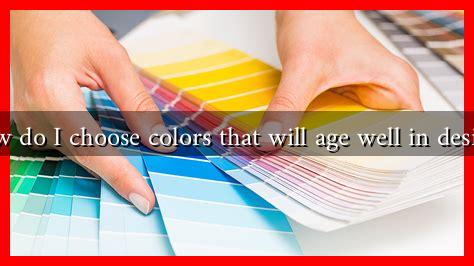-
Table of Contents
How Do I Choose Colors That Will Age Well in Design?
Choosing colors that will stand the test of time in design is a crucial skill for designers, marketers, and anyone involved in visual communication. The right color palette can evoke emotions, convey messages, and create lasting impressions. However, trends come and go, and what seems appealing today may not resonate in the future. This article explores how to select colors that will age gracefully, ensuring your designs remain relevant and appealing over time.
The Psychology of Color
Understanding the psychology of color is essential when selecting a palette that will endure. Colors can evoke specific emotions and associations, which can change over time. Here are some key points to consider:
- Warm Colors: Reds, oranges, and yellows are often associated with energy and excitement. However, they can also become overwhelming if overused.
- Cool Colors: Blues, greens, and purples tend to evoke calmness and tranquility. These colors often age well due to their versatility.
- Neutrals: Whites, grays, and beiges provide a timeless backdrop that can complement any design. They are often the safest choice for long-lasting appeal.
Timeless Color Palettes
Some color combinations have proven to be timeless. Here are a few classic palettes that have aged well:
- Black and White: This combination is the epitome of elegance and sophistication. It works in various contexts, from fashion to interior design.
- Earth Tones: Colors like browns, greens, and muted yellows reflect nature and tend to remain in style due to their organic feel.
- Monochromatic Schemes: Using different shades of a single color can create a cohesive and sophisticated look that ages gracefully.
Consider Cultural Context
Colors can have different meanings in various cultures, which can affect their longevity in design. For instance, while white is often associated with purity in Western cultures, it can symbolize mourning in some Eastern cultures. When designing for a global audience, it’s essential to consider these cultural nuances. Researching color meanings in different cultures can help you avoid potential pitfalls and ensure your design resonates positively across diverse audiences.
Trends vs. Timelessness
While it’s tempting to follow current design trends, it’s crucial to differentiate between fleeting fads and timeless choices. Here are some tips to help you navigate this landscape:
- Research Historical Trends: Look at color trends from the past decades. Colors that have consistently appeared in design are likely to age well.
- Use Trendy Colors Sparingly: If you want to incorporate trendy colors, do so as accents rather than the main palette. This approach allows you to stay current without compromising timelessness.
- Focus on Versatility: Choose colors that can be easily adapted to different contexts and applications.
Case Studies: Brands That Have Mastered Timeless Color Choices
Several brands have successfully chosen colors that have aged well, serving as excellent case studies:
- Coca-Cola: The iconic red and white color scheme has remained largely unchanged since the late 19th century, symbolizing energy and excitement.
- Apple: The minimalist use of white and silver in Apple’s branding has created a timeless aesthetic that emphasizes simplicity and innovation.
- Starbucks: The green and white color palette evokes a sense of calm and connection to nature, which has helped the brand maintain its appeal over the years.
Conclusion
Choosing colors that will age well in design requires a thoughtful approach that considers psychology, cultural context, and the balance between trends and timelessness. By focusing on classic palettes, understanding the emotional impact of colors, and learning from successful brands, you can create designs that remain relevant and appealing for years to come. Remember, the goal is not just to create something beautiful today but to design with longevity in mind.
For further reading on color theory and its applications in design, consider visiting Color Psychology.

